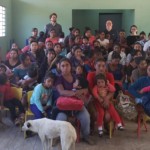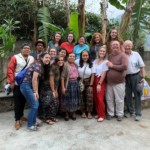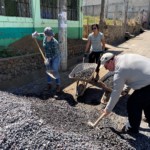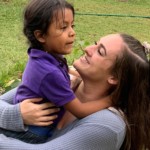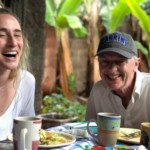Eleven Cabrini University students, one alumna, three faculty members and the Director of the Wolfington Center participated in an immersion trip to San Lucas Tolimán, Guatemala over [the recent] Spring Break. The trip was led for an 11th year by Communications Professor Dr. Jerry Zurek and Romance Languages and Literatures Professor Dr. Raquel Green, as part of their Engagements with the Common Good course entitled “Working for
Justice in Guatemala”.
All participants spent the week working in the mornings on construction projects in and around San Lucas Tolimán, and being educated on the numerous initiatives of the San Lucas Mission to promote health, education and the empowerment of women in the region.
San Lucas Tolimán is a community of roughly twenty thousand people located on the southeastern edge of Lake Atitlán, which was once famously described by naturalist and explorer Alexander von Humboldt as the “most beautiful lake on Earth.” It is located in an area of Guatemala that was ravaged during the thirty-five year Guatemalan Civil War, particularly during the early 1980s, when Blessed Father Stanley Rother of neighboring Santiago Atitlán was one of several Catholic priests murdered in the country. In San Lucas Tolimán, Father Gregory Schaffer also was threatened with death, and one of his closest workers in the Mission was disappeared in the same year.
Despite such ever-present violence and deeply entrenched material poverty, Father Greg was able to profoundly alter the conditions of the area by empowering lasting social change rooted in the needs as stated by the community. Today, nearly seven years after Father Greg’s death, the staff and long-term volunteers of the Mission work alongside numerous visiting groups to engage in projects that support basic material needs and also contribute to the communal and spiritual growth of the residents of the area.
“Working in the community really opened my eyes to the spiritual richness of the people of San Lucas Tolimán, which is what I will forever focus on instead of their material deprivation. I learned so much from each person about grace, dignity and respect,” said Dr. Todd Matthews, one of the faculty members on the trip.
In addition to San Lucas Tolimán, Dr. Ray Ward, Director of the Wolfington Center, Dr. Melissa González-Contreras and Dr. Matthews also had the opportunity to spend a day at the Dispensario Madre Cabrini in the town of Bárcena, close to Guatemala City and roughly three hours from San Lucas Tolimán. There they were able to meet with Sister Juanita of the Missionary Sisters, along with the Administrator of the Dispensario, Claudia Aceituno, and several members of the staff. They also saw the tremendous work being done by the Missionary Sisters and lay staff with the residents of Bárcena and surrounding villages. The Dispensario operates a medical clinic, provides psychological services, vocational training and a variety of other services such as a school and workshops that particularly aim to educate and empower women.
In the hillside village of El Tablón, a women’s center has been established, where roughly 1/3 of the women in the community regularly meet to learn about leadership and women’s rights along with providing social support to each other. Compared to San Lucas Tolimán, these efforts are in the nascent stage of development but are already having a significant impact on the lives of those in a community where most children are not able to go beyond a grade school education and many of them are married in their early teens.
Social change is slow and often frustrating, but the work done by the Missionary Sisters in Bárcena and all of the participants in the San Lucas Tolimán Mission is directly improving the lives of countless Guatemalans and is a powerful reminder of the beauty and impact of what Mother Cabrini started over a century ago. We may not change the world, but lives can be transformed, as we saw happening to ourselves and to the people in these two missions we were privileged to visit. ~ submitted by Dr. Todd Matthews

